|
|
|
|
|

|
|
-
Maths Everywhere and Anywhere:
Up until now, MathType has been thought of mostly as a tool that
works with Microsoft Word and PowerPoint. But it has always been
much more than that. MathType currently
works with
800+
of the most popular applications and websites
used by education, web authoring, engineering, and computational
systems.
-
MathType Application and Website Compatibility Database
(see
Works With ...): We
have built an online database of over 1,000
applications and websites, 800+ of which MathType already works with. MathType includes
help pages for many describing the best way to work with them. If
your favourite application or website is not in the list, MathType
probably still works with it using one of the general techniques and
mechanisms listed below.
-
Insert Object (OLE): Many applications have an Insert Object command
that allows MathType equations to be
inserted into their documents just as in
Microsoft Word and other Office applications. This
is also called OLE (Object Linking and
Embedding).
-
Cut, copy, and
paste: Any application that lets you
paste an image from the clipboard will work
with MathType, allowing you to insert
equations into literally thousands of
document types.
-
Paste a table from a spreadsheet,
document, or web page into MathType as
a matrix: MathType lets you copy
a table from a spreadsheet (e.g. Excel), document (e.g. Word), or web
page, and paste it into MathType as a matrix.
- Drag and drop:
Just like cut and paste, drag and drop can
be used to put equations in many kinds of
documents.
- Equation image files:
MathType can save equations as image files
in these formats: EPS, GIF, or WMF. Many applications
allow you to import these into their
documents.
- MathML, TeX, LaTeX import and export:
Now you can import
and export mathematics defined using MathML or TeX to/from the many applications
that work with those formats. MathML code can be either in the new MathML
Clipboard Format that is supported by a growing number of
mathematical and scientific applications or plain text such as from
an XML editor, for example. MathML or TeX can be imported via cut
and paste or drag and drop.
- Translators for TeX, MathML, Maple,
Mathematica, MATLAB, Gmail, Physics Forum and more: MathType has many built-in
translators that adapt it to work with various languages, products,
and websites. We are continuing
to develop new translators and, using our MathType SDK, you can
customise them or create your own.
|
|
MathType now works with 800+ applications
and websites.
Wikipedia,
the popular online encyclopedia, contains 1000s of
pages with mathematical equations you can copy to
use in your own work:
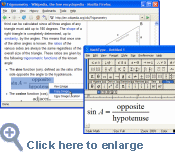 |
-
Supports Microsoft Office 365, 2016, 2013, Office 365, 2010, 2007, 2003, and XP (2002)
- Office 2016 and Office 365: MathType 6.9 is fully compatible with Office 2016 and Office 365.
- Office 2013, 2010, 2007, 2003, and XP: MathType 6.9 is fully compatible.
- Office Web Apps, Office Mobile, and Office RT: MathType equations cannot be edited in these Office versions but equations created in other versions of Office will display and print.
- Office 32- and 64-bit: MathType 6.9 is compatible with both 32- and 64-bit versions of Office.
|
-
Insert Equation:
The MathType tab on Word's Ribbon
makes it easy to insert
equations,
with or without equation numbers. No need to use the clunky Insert
Object dialog.
-
MathType
Commands: The MathType tab also gives quick
access to commands to renumber equations on
the fly, insert equation references, and to
convert a Word document to a web page, all
while working in Word.
|
|
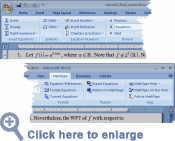 |
-
Insert Equation:
MathType installs a toolbar into Word,
giving you the ability to insert
mathematical notation inline or centered,
with or without equation numbers, with just
a click. No need to use the clunky Insert
Object dialog.
-
MathType
toolbar and menu: The toolbar also gives quick
access to commands to renumber equations on
the fly, insert equation references, to
convert a Word document to a web page, all
while working in Word.
|
|
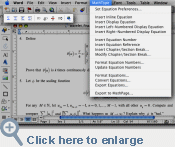 |
- Format Equations:
MathType adds its own menu in Word that
contains useful commands. One of these,
Format Equations, lets you change the font
and style of all equations in a document.
|
|
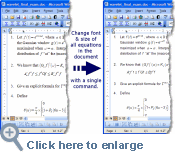
|
- MathPage:
MathType includes our MathPage™
technology that easily converts Microsoft
Word documents into web pages, properly
handling mathematical symbols as well as
MathType and Equation Editor equations.
- MathML or GIF:
MathPage can generate equations as
either GIF images or MathML. MathML will
allow you to copy and paste math into many
applications that understand MathML.
-
Exact Speech command: Overrides
the automatically generated speech used by
MathPlayer's math-to-speech or
braille conversion for a selected expression
or symbol. This is important in a number of situations, such as in an assessment situation where the normal speech text
from screen readers or other accessible
technology (AT) might give away the answer.
- Maths
accessibility: MathML is the key to
math
accessibility, allowing equations in web
pages to be spoken by screen readers that
are used by the blind and others.
|
|
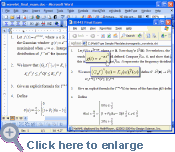 |
- Two editing
modes: MathType allows you to edit
equations inline like Equation Editor
or, if you prefer, in a separate window.
- Multiple zoom
levels: It can be hard to read small
subscripts, superscripts and accents (primes
and hats) while editing an equation inline
in a Word document viewed at normal zoom
levels. MathType allows you edit equations
at 400%, for example, while working with
your document at a normal zoom level.
|
|
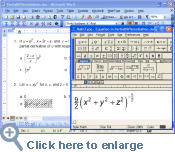 |
|
|
|
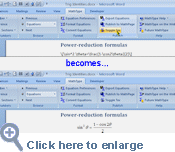 |
- Insert Equation Numbers: Insert
chapter, section and equation numbers on
either the right or left-hand side of your
equations. If you later insert new equations
into the middle of your document, the entire
document is automatically renumbered.
- Format Equation Numbers:
Customize equation numbering formats by
choosing Roman or Arabic numerals, upper and
lower case letters, and any type of
enclosure and separator for styles applied
to chapter, section and equation numbers.
|
|
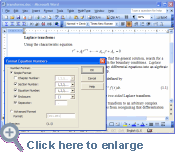 |
- Extends Word's Browse Feature:
Use MathType's equation browser to review all equations in your
document or check all equation numbers and
references for consistency. Buttons allow
you to move forward or backward in the
document one equation or number at a time.
|
|
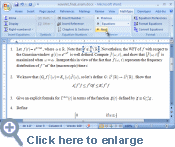
|
- Export Equations: Automatically
export all equations in a document as image
files in these formats: EPS, GIF, or WMF.
- QuarkXPress, InDesign, FrontPage,
Dreamweaver: If you are working with page
layout or HTML-authoring software, this
command will save you time by not having to
open and save each equation individually.
- Convert Equations: Convert all
equations in a document to TeX, LaTeX or
MathML in preparation for a custom export
process.
|
|
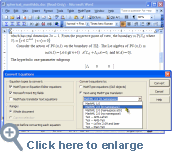 |
| |
|
|
|
|
|
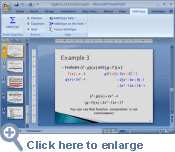
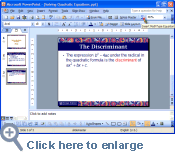
|
|
|
|
TeX is a typesetting language invented in the
70's that's popular with some mathematicians,
physicists, and chemists. LaTeX is a popular
derivative of TeX. While TeX has a long learning
curve, if your hands already "know" TeX syntax,
you can leverage that knowledge while still
reaping MathType's advantages in easy editing
and application/document compatibility.
-
Type
equations in TeX directly into Word:
You
can type TeX directly into your Microsoft Word
document. When you are done, type Alt+\
(Toggle TeX) to convert it to a MathType
equation. Later, if you want to edit the
equation's TeX code, just type Alt+\ again.
The Toggle TeX command allows you to switch
between TeX and MathType views of the
equation.
-
Mix typing TeX with
point-and-click editing:
You
can enter equations quickly using MathType's
TeX input mode. TeX editing can be mixed
with point-and-click editing so you get the
best of both worlds.
-
Paste TeX from existing
documents:
Many TeX users have existing documents with
lots of equations. Just copy them to the
clipboard and paste into a MathType equation
window to avoid retyping them.
-
Export equations to
TeX/LaTeX:
MathType comes with translators for several
variant's of TeX/LaTeX:
- Plain TeX (as described in Donald
Knuth's The TeX Book)
- AMS-TeX (Plain TeX with extensions
from the American Mathematical Society)
- LaTeX (version 2.09 and later)
- AMS-LaTeX (LaTeX with AMS extensions)
-
Customisable
translators: Each translator is defined
in a text file using a simple scripting
language. This allows you to customize any
of our translators to suit your own needs,
or even create one from scratch.
|
|
Type equations in TeX directly into Word:

Mix typing TeX with point-and-click editing:
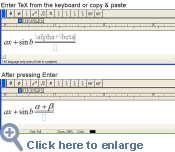
|
|
|
|
- More symbols and
templates: MathType has hundreds more
symbols and templates than Equation Editor.
Beside our exclusive Euclid™ math fonts, you
can also make use of the 1000's of maths
symbols in fonts already on your computer,
as well as maths fonts you can download from
the Internet.
- Insert Symbol
Dialog: MathType's Insert Symbol dialog allows you to explore the available symbols and
insert them with a click or keystroke.
- Search for
characters based on words in their Unicode
description: MathType contains a
database of character descriptions and
knowledge of what characters are contained
in most maths fonts. For example, search for
"less" to see the many variations of the <
symbol.
|
|
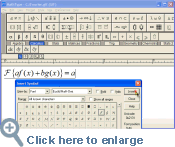 |
|
- Great for slide
presentations and teaching: Colouring an
equation can make it stand out in a slide
show. Use colour to highlight part of an equation to focus
your students' attention on it. Show the
part that changed in each step of a
multi-step procedure.
- CMYK, RGB, spot
colours: MathType also handles CMYK, RGB
and spot colour for page layout software,
such as QuarkXPress and Adobe InDesign.
|
|
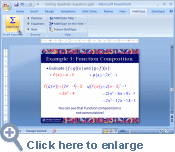 |
|
- Shortcuts for
virtually every command: While pull-down
menus make MathType easy, keyboard shortcuts
make it fast as well, allowing power users
to drive MathType without taking their hands
off the keyboard.
- Assign new
shortcuts to your favourite symbols or
equations: You can assign your own
keyboard shortcut to any symbol from any
font, or any equation or expression you want
to insert quickly from the keyboard.
|
|
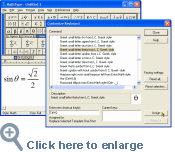 |
|
- GIF images: MathType creates
smooth-looking GIF equations on either colour
or transparent backgrounds. Since MathType's
image generation is optimized for
mathematical notation, equation images
created with MathType look much better than
those created by other tools.
- EPS: EPS is often the format of choice for
professional publishing with QuarkXPress,
Adobe InDesign, PageMaker and other page
layout programs.
- WMF: WMF is the standard file
format for line art for Microsoft Windows
operating systems.
- Automatic file numbering: MathType
can automatically number the equation files it
saves, making it easy to save a sequence of
equation files having similar filenames (e.g.
"eqn1", "eqn2", and so on). This is especially
handy when working with GIF files or EPS
files.
|
|
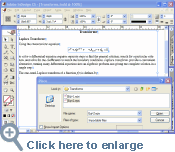
|
|
- Unlike Equation
Editor, MathType lets you undo your editing
one step at a time, all the way back to the
way your equation was at the start of the
session.
|
|
|
|
- Design Science worked with ViewPlus,
Inc. to allow you to prepare Word documents
that can be printed on a ViewPlus Tiger
Embosser. See ViewPlus'
Fast and Easy Braille Math Translation
for details.
|
|
|
|
- MathType applies the
rules of mathematical typesetting as you
type. It automatically chooses fonts, style,
spacing and position as you enter the
equation. You can modify MathType's rules to
accommodate your own style, or switch
between automatic formatting and plain text
modes with a single keystroke. For maximum
flexibility and control, MathType gives you
the ability to nudge equation elements in
1/4 point increments.
|
|
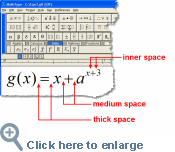 |
|
-
Unlike Equation Editor,
MathType allows you to add or delete rows
and columns within existing matrices and
tables by using the commands on the new
Matrix menu.
|
|
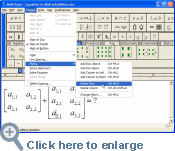
|
|
- Saves time: Holds hundreds of your
most frequently used symbols, expressions, and
equations.
- Drag and drop expressions: Drag
from your equation and drop onto the toolbar.
- Insert symbols or expressions with just
a keystroke: Associate a keyboard shortcut
with any symbol, template, or expression so
that it can be inserted later using just the
keyboard.
- Named tabs: Organize your toolbar
expressions and symbols using named tabs (e.g.
“Geometry”, “Science”, etc.). Customize the
names as you see fit.
|
|
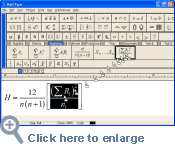 |
|
- MathML:
MathML
is an XML-based language adopted as a
Recommendation by the World Wide Web
Consortium, the main standards body
governing the web. If you are interested in
learning more about MathML, a good place to
start is our
Math on the Web section of this site.
- Customisable
translators: Each translator is defined
in a text file using a simple scripting
language. This allows you to customise any
of our translators to suit your own needs,
or even create one from scratch.
|
|
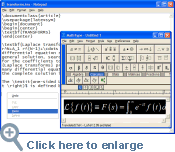 |
|
- Automatic function recognition:
When you type “sin”, “cos”, “lim”, etc.,
MathType understands you are typing a
function and will automatically change its
font to “function style”.
- Add your own functions: You can
also add your own functions to the list that
MathType recognises.
|
|
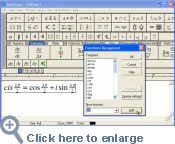
|
|
- You can choose from three different
viewing sizes for MathType's toolbars,
making it easy to adjust the way you work to
both small and large screens, as well as
make it easier for those that simply like
larger buttons.
|
|
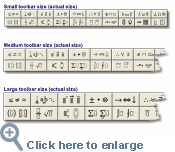 |
|
- Asian characters: Supports input
of East Asian characters on Windows and Mac
OS using standard input methods.
- Accents: European accented
character support.
- Multiple soft keyboards: When
multiple “keyboards” are installed, you can
choose to have MathType automatically switch
keyboards when you switch styles and
vice-versa. (Windows version)
|
|
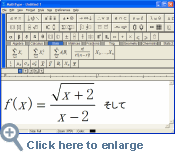 |





















